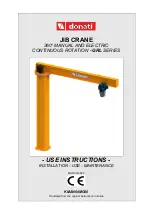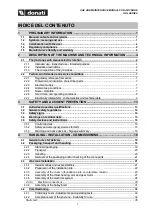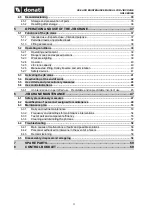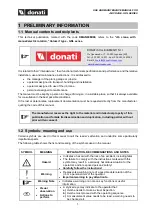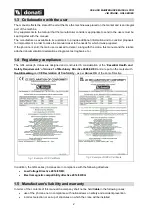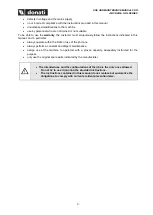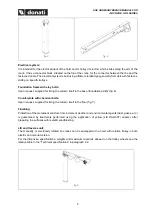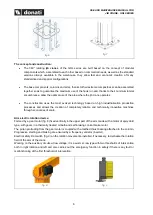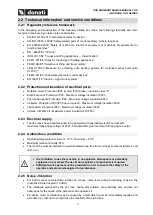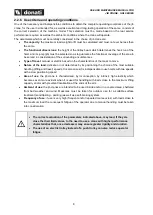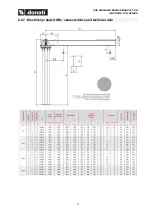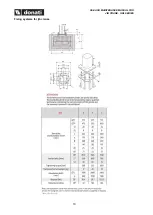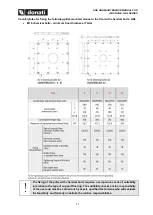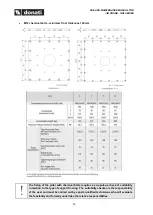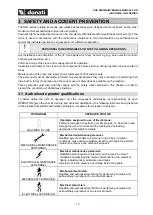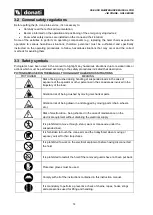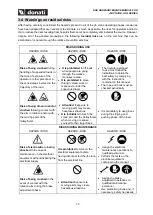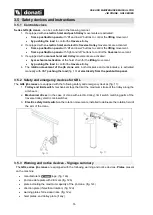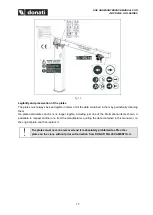
USE AND MAINTENANCE MANUAL FOR
JIB CRANE
-
GRL SERIES
4
2 DESCRIPTION OF THE MACHINE AND TECHNICAL
INFORMATION
2.1 The jib cranes with manual/electric rotation
2.1.1 Intended use - Expected use - Intended purpose
The jib cranes
, with manual/electric rotation, in “Column” version - GRL series are created to locally handle
goods inside a plant, on a loading dock or along with operating stations.
Jib cranes
perform three operations:
•
they lift
the load vertically in space, via a hook on the lifting unit, generally composed of a manual
or electric chain hoist and using accessories suitable for this operation;
•
they traverse
the load in space, with the assistance of an electric or manual hoist holder trolley,
which runs along the radial axis of the crane arm;
•
they rotate
the load in space, around the constrained axis of the arm, through a manual push
action of the load using the circular area below, limited by the rotation radius of the arm.
2.1.2 Installation restrictions
The “Column-mounted” - GRL
series jib cranes
, are generally designed to be attached to the ground,
the column is self-bearing and can be anchored to the ground with stay bolts, on a specific foundation plinth
or, in special cases after verifying the feasibility, also with expansion bolts or chemical anchoring.
•
The user must verify, either directly or through personnel specialised in the matter,
the suitability of the anchoring surfaces which must ensure the stability and safety
of the crane in all operating conditions, withstanding the stress and dynamic
effects induced by the overturning moment and the lifting type and speed.
2.1.3 The composition of the jib cranes
The composition of the jib crane is relatively simple: the metalwork structure, lifting unit composed of a
hoist (electric or manual), the traverse unit formed by hoist holder trolley (electric or by pushing) and a
series of accessories (tie-rods, foundation plinth, electrical system, etc.).
The GRL series
crane is composed of a column with polygonal section attached via stay bolts or bolts to
the specifically dimensioned base and of a rotating arm situated on the column itself.
Column:
Made of press-forged steel sheet welded to the tubular structure with polygonal section it allows
high rigidity and stability for the crane; it is fixed to the base with a base plate and a system of bolts or stay
bolts. In the upper part a pair of plates supports the crane arm and allows it to rotate (fig. 3).
Rotating arm:
The arm, turning around its axis on thrust bearing, is composed of a weight-bearing beam
for travel of the hoist holder trolley and is created for
capacities from 125 to 2,000 kg and jibs up to 7 m
(fig. 4).Made using a laminated double T-beam form: the hoist carrying trolley runs on the lower flanges of
the T-beam. The beam is self-bearing with cantilever, therefore it does not have support bolts. Allows
optimal use of the available overhead space due to the absence of bolts. The crane can be used in
combination with electric or mechanical push-trolleys.
Summary of Contents for GRL Series
Page 2: ......
Page 14: ...USE AND MAINTENANCE MANUAL FOR JIB CRANE GRL SERIES 10 Fixing systems for jib cranes ...
Page 64: ......

